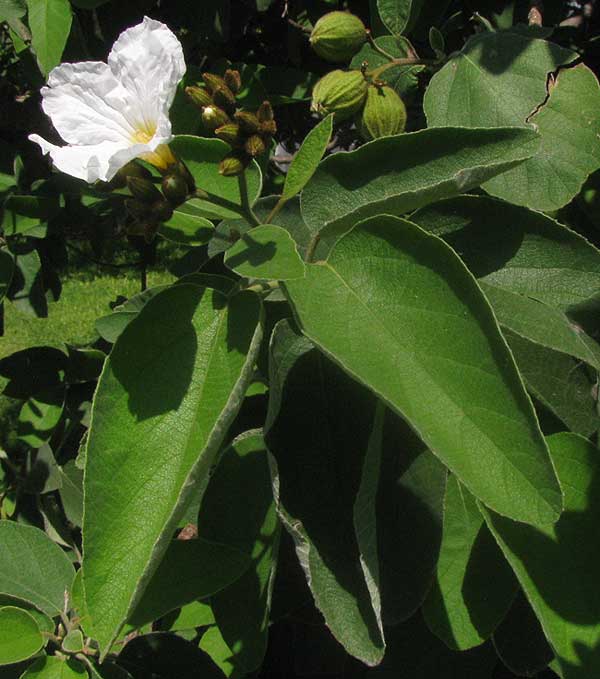Excerpts from Jim Conrad's
Naturalist Newsletter

from the June 8, 2014 Newsletter issued from the Frio Canyon Nature Education Center in the valley of the Dry Frio River in northern Uvalde County, southwestern Texas, on the southern border of the Edwards Plateau; elevation ~1750m (~5750 ft); N29.62°, W99.86°; USA
TEXAS OLIVE
Along Main Street in Uvalde here and there they've planted some small, dense trees about the size and shape of healthy, well watered apple trees, but bearing largish, egg-shaped leaves and -- at least during the last few weeks -- white, yellow-throated, funnel-shaped flowers two inches across (5cm). Flowering season is almost over and this week I had to look around to find a single flower, but that one is shown above. The trees are heavy, however, with developing, drupe-type fruits covered with fuzzy, baglike calyxes, a cluster of which is shown below:

We've seen this tree before, not planted along a busy highway but growing naturally and very prettily -- though smaller, much less dense and more gnarly -- on a hot, dry, scrubby slope in Querétaro, north-central Mexico. There we learned to call it Anacahuite, but in these parts it's called Texas Olive, or Mexican Olive, though it's not related to real olive trees. It's also known as White Geiger Tree. It's CORDIA BOISSIERI, a member of the Borage or Forget-me-not Family, a family that to most Temperate Zone folks is known more for its herbaceous members than its woody ones.
Texas Olive's native range is mainly arid northeastern and central Mexico, but it extends into Texas. I'm unsure whether we're within its native range. Though it certainly prospers in Uvalde, here it loses its leaves after hard freezes, but in Mexico manages to be an evergreen.
Though the fruits are sweet, I read that they're slightly toxic when fresh, causing dizziness in humans and other animals. Still, jellies made from the fruits seem to be safe. Syrup extracted from the fruits is used to dye cloth and treat coughs. Traditionally the leaves have been used medicinally for "rheumatism" and lung ailments. The wood is used as firewood and for carpentry.
And it does good service making things pretty and adding some greenery along Uvalde's Main Street.